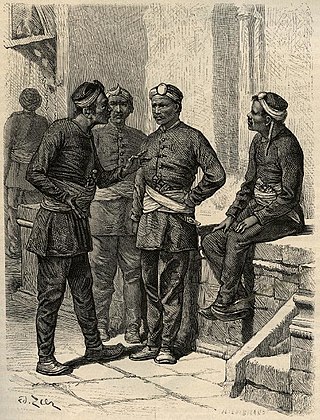
The Gurkhas or Gorkhas, with the endonym Gorkhali, are soldiers native to the Indian subcontinent, chiefly residing within Nepal and some parts of North India.
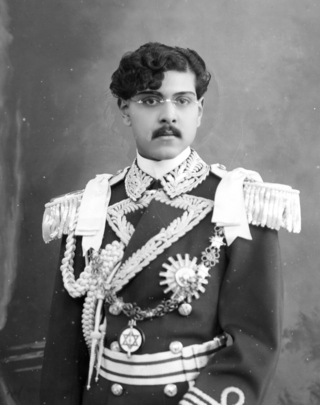
Tribhuvan Bir Bikram Shah was the King of Nepal from 11 December 1911 until his death in 1955. Born in Kathmandu, the capital city of Nepal, he ascended to the throne at the age of five, upon the death of his father, Prithvi Bir Bikram Shah, and was crowned on 20 February 1913 at the Nasal Chowk, Hanuman Dhoka Palace in Kathmandu, with his mother acting as regent. At the time of his crowning, the position of monarch was largely ceremonial, with the real governing power residing with the Rana family.
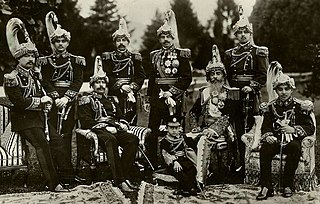
The Rana dynasty were a Chhetri dynasty that imposed authoritarianism in the Kingdom of Nepal from 1846 until 1951, reducing the Shah monarch to a figurehead and making the Prime Minister and other government positions held by the Ranas hereditary. They are Kshatriya, whose ancestors were descended from the Ranas of Udaipur, Rajasthan, India. The Rana dynasty is historically known for their iron-fisted rule. This changed after the Revolution of 1951 with the promulgation of a new constitution, when power shifted back to the monarchy of King Tribhuvan.

The Rastrapati Bhawan is the official residence of the President of Nepal, located in Kathmandu, Nepal. It hosts the Office of The President of Nepal. The main palace building is also known as Shital Niwas. It was built by Prime Minister Chandra Shumsher Jung Bahadur Rana in 1923.
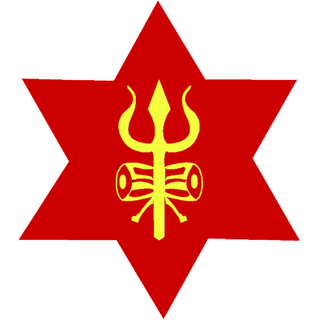
The Nepali Army, also referred as the Gorkhali Army, is the land service branch of the Nepali Armed Forces. After the Gorkha Kingdom was founded in 1559, its army was established in 1560, and was accordingly known as the Gorkhali Army. The army later became known as the Royal Nepali Army (RNA) following the Unification of Nepal, when the Gorkha Kingdom expanded its territory to include the whole country, by conquering and annexing the other states in the region, resulting in the establishment of a single united Hindu monarchy over all of Nepal. It was officially renamed simply to the Nepali Army on 28 May 2008, upon the abolition of the 240-year-old Nepalese monarchy, and of the 449-year-old rule of the Shah dynasty, shortly after the Nepalese Civil War.
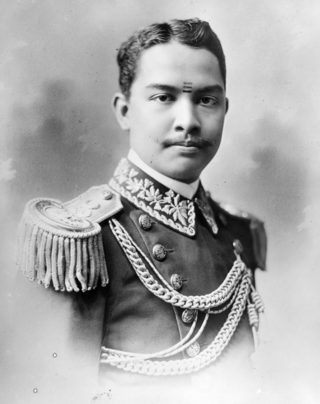
Field Marshal Sir Kaiser Shumsher Jang Bahadur Rana, GBE was a field marshal in the Royal Nepalese Army. He was the third son of Maharaja Sir Chandra Shamsher Jang Bahadur Rana, GCB, GCSI, GCMG, GCVO the fifth Prime Minister of Nepal of the Rana dynasty and Bada Maharani Chandra Loka Bhaktha Rajya Lakshmi.
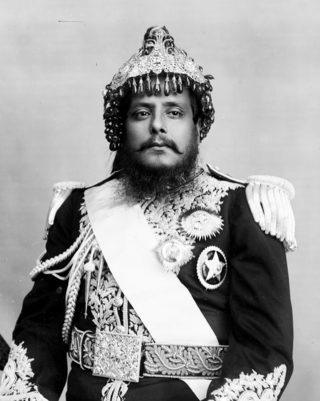
Commanding General Shree 3 Maharaja Sir Bir Shumsher Jung Bahadur Rana was the 11th Prime Minister of Nepal. He is remembered as a statesman who made reforms and infrastructure improvements. Bir Shamsher Jung Bahadur Rana was known as Kailay in his childhood; this name was given by Jung Bahadur. His mother was daughter of Pahalman Singh Basnyat and sister of Lalitman Singh Basnyat. His mother died at his birth and he was taken care of by Putali Maharani, wife of Jung Bahadur. He spent his childhood at Thapathali Durbar.

Sir Baber Shumsher Jung Bahadur Rana, GCVO, GBE, KCSI, KCIE was a member of the Rana dynasty who served as the Minister of Defence of Nepal in 1951. A prominent member of the Rana oligarchy, he fought valiantly in the First World War. He was the second son of Maharaja Sir Chandra Shamsher Jang Bahadur Rana and Bada Maharani Chandra Loka Bhakta Lakshmi Devi. He was the younger brother of Maharaja Sir Mohan Shamsher Jang Bahadur Rana and older brother of Field Marshal Sir Kaiser Shamsher Jang Bahadur Rana.
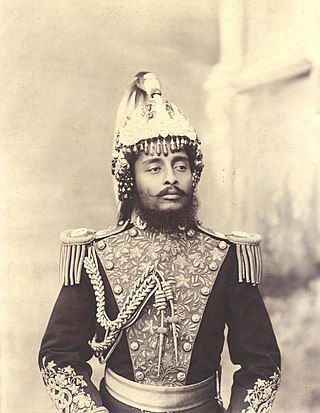
Field-Marshal His Highness Maharaja Sri Teen Chandra Shumsher Jung Bahadur Rana was the Prime Minister of Nepal from the Rana dynasty. He served in this capacity from 27 June 1901 to his death in 1929 after he successfully deposed his liberal and reformist brother Dev Shamsher. Although generally perceived as despotic and conservative, he is credited with several reforms including the abolition of slavery and establishing the Nepal-Britain Treaty of 1923, which recognised Nepal as an independent nation and an ally of Britain.
Commander in Chief Kiran Shamsher Jang Bahadur Rana (1916–1983) was a Nepalese army officer. He served as the Royal Nepalese Army's Commander-in-Chief from 1951–1956 and as the Nepalese ambassador to the United Kingdom from 1973–1977. Over the course of thirty years, he served as Aide-de-camp General to King Tribhuvan, King Mahendra and King Birendra.
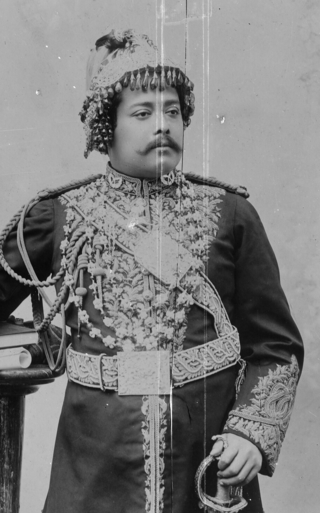
Sri Maharaja, Dev Shumsher Jung Bahadur Rana was the Prime Minister of Nepal for 114 days in 1901. He was also the King of Lamjung and Kaski.
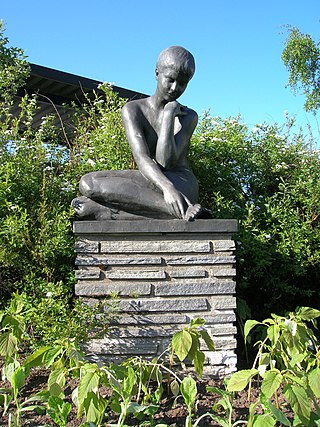
Rana is a given name and surname of multiple origins.
The 14th Indian Infantry Brigade was an infantry brigade formation of the Indian Army during World War II. The brigade was formed at Attock, now in Pakistan, in October 1940, and assigned to the 7th Indian Infantry Division. In April 1942, the brigade was renumbered as the 114th Indian Infantry Brigade. The brigade fought in the Burma Campaign with the 7th Indian Division and later the 26th Indian Infantry Division.
The Nowshera Brigade was an infantry brigade formation of the Indian Army during World War II. It was formed in September 1939, for service on the North West Frontier. It was normal practice for newly formed battalions to be posted to the North West Frontier for service before being sent to Africa, Burma or Italy.
The Thal Brigade was an Infantry formation of the Indian Army during World War II. It was formed in November 1938, for service on the North West Frontier. It was normal practice for newly formed battalions to be posted to the North West Frontier for service before being sent to Africa, Burma or Italy.
The Nepalese Army participated in World War I with The First Rifle, Kalibox, Sumsher Dal, Jabbar Jung, Pashupati Prasad, Bhairab Nath, Second Rifle, Bhairung and Srinath Battalions. The total number of NA troops deployed to India at the time was 14,000, though some sources claim it to be as 16,000. Troops were armed with the Martini-Henry and Enfield rifles. General Babar Shumsher, General Tej Shumsher and General Padma Shumsher, were the main commanders. The discipline, professionalism and adaptability of the Nepalese soldiers was again well respected in the First World War. Additionally, Nepal also sent almost two hundred thousand troops, and proportionately a higher percentage of military aged men than most countries, to fight as part of the British Indian Army itself. Nepal also provided financial aid to the British government, in the form of 1 million pounds.
Nir Shumsher Jung Bahadur Rana. Field Marshal and retired General of the Nepal Army (NA). Born on 11 Poush, 1970 B.S. (1913) in Jawalakhel Durbar, Jawalakhel, Lalitpur, Field Marshal Rana died at the age of 99. He was son of the then ruling Rana Prime Minister Juddha Shumsher Rana and his second wife, Mahila Maharani Krishna Kumari. According to a statement, the centenarian Field Marshal had joined the then Royal Nepal Army (RNA) at the age of 18 on 1 Shrawan 1988 B.S (1931) and was appointed to the post of Major at the Shri Pashupati Prasad Battalion. He became the Commander-in-Chief of the RNA on 15 Baisakh, 2017 B.S (1960) and retired on 15 Baisakh in 2022 B.S (1965). He was appointed Field Marshal after his retirement in 2022 B.S.

Bhim Shumsher Jung Bahadur Rana ruled Nepal from 26 November 1929 until his death on 1 September 1932. He was born on 16 April 1865.

Dhir Shumsher Kunwar after 1848 known as Dhir Shumsher Kunwar Ranaji or Dhir Shumsher Jang Kunwar Ranaji or shortly Dhir Shumsher Rana posthumously known as Dhir Shumsher Jang Bahadur Rana was a Nepalese politician, army general, and minister of state. He served as the Commander-In-Chief of the Nepalese Army from 1879 to 1884.














